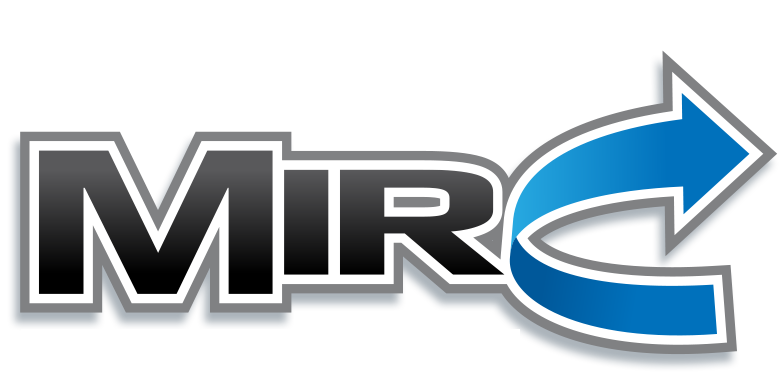Direct Wired Contact Closure Remote Relay Controller 4-Channel Solid State 1-Way
Highlights
- Transmitter Includes 4 Contact Closure Inputs
- Receiver Includes 4-Channel SPST Solid-State Relays
- Sold in Pairs with up to 1000′ Range 3-Wire Connection
- Transmitter Communicate using 2-Way Communications
- Transmitter Controls Remote Relays
- Receiver Displays Status of Remote Relays
- No Configuration, Computers, or Programming
- Beacon Mode for Range Testing
- Smart Mode for Fast, Protected Operation
- Relay and Communication LED Status Lights
- Auto Shut-Off when Communications is Lost
Ethernet Contact Closure 1-Way Transmitter Receiver Pair
Our MirC 4-Channel Solid-State Relay Controllers are manufactured in pairs, designed to work together when powered up using 3-wire communications. The contact closure inputs on the transmitter control the relays on the receiving relay controller. Both the transmitter and receiving relay control display the relay status using LEDs. MirC controllers communicate to each other using just 3 wires over distances up to 1,000 feet. Use just about any type of network wire, including Cat3, Cat5, Cat6, or whatever else you may have for best communication distance. MirC controllers use screw terminals to connect 3 communication wires between controllers.
Customize this MirC controller for the type of solid-state relays your application requires during the order process. Solid-state relays are of the SPST variety, and are typically used for high-reliability and long-life AC or DC switching applications. Remotely control motors, pumps, valves, solenoids, lights, and other heavy duty electrical equipment by simply wiring a switch in one location to control your electrical equipment in a remote location. On-board Relay status LEDs and busy/ready LEDs let you know when these controllers are talking to each other. When communications is lost, on-board relays will automatically deactivate within 30 seconds.
4-Channel Solid State Contact Closure Transmitter and Receiver Video

MirC Controllers Mirror Contact Closures in a Remote Location. A contact closure input is converted to a data signal and transmitted to a remote relay controller via 3 wires, which provides a remote contact closure output as well as 2-way confirmation and verification.
Wireless MirC Remote Contact Closure Transmitter and Receiver Controllers
Contact Closure Inputs in one location control remote relays in a remote location using a 3-Wire data signal with verification. Mirror controllers are ready to go to work immediately. No Computers, No Configuration – Works Right Out of the Box. MirC controllers stay connected to each other by communicating with each other constantly. Inputs on the transmitting controller activate the relays on the receiving controller.
Permanently Married
MirC is Always Trying to Talk to it’s Mate!
MirC controllers are always talking to each other. They stay in relentless communications for optimal reliability. Should they lose communication with each other, they will keep calling out for each other until they find their mate.
Syncing Up
MirC controllers are equipped with contact closure inputs on the transmitter and relay outputs on the receiver. The inputs on the transmitter activate the relays on the remote receiver using 3 wires for communications between controllers. The transmitter displays the status of the remote relays using LEDs (one LED per relay), so both the transmitter and receiver include relay status! Every MirC controller is equipped with a Busy/Ready LED. If the Busy LED flashes, this indicates the remote device has successfully received and accepted your contact closure status. If the Busy LED does not flash, the remote device is not properly connected or there is a break in one of the three communication wires.

Beacon Mode
Beacon Mode communicates with a Remote MirC controller many times per second, refreshing Relay Status information every time a valid data stream is received by the remote device. Relays are only refreshed when a valid data packet is received. If data is lost, the Ready LED will stay on and Relays will stay in their current state. If the remote MirC controller is in range, the Busy LED will flash periodically, indicating valid communications between devices. Beacon Mode is slower than Smart Mode and is used primarily for initial testing of two devices.
Smart Mode
Once you have determined an installation location for both MirC controllers, move the Beacon/Smart jumper to the Smart position. Smart Mode communicates to the remote device any time a change is detected on the local device. Otherwise, the controller periodically checks to make sure the remote device is in range. Smart Mode is significantly faster than Beacon Mode. Smart Mode is the preferred mode for daily use in most applications. Note that each MirC controller can be set to a different mode and jumper changes take effect immediately. Again, the Busy LED will indicate the remote device is properly communicating. Smart Mode will also verify the relays on the remote device are properly set. If they are not, Smart Mode will attempt communications until the remote device responds. If communications is lost between the MirC controllers, all relays will automatically shut off within 30 seconds. If this is not desirable, Beacon Mode should be used.
Beacon Mode vs. Smart Mode
Perhaps the most notable difference between Beacon and Smart Mode is how relays respond if communication is lost. In Beacon Mode, the relays will stay in their current state and will not change unless a new data packet is received. In Smart Mode, relays will turn off automatically in 10 to 30 seconds if communications is lost between MirC controllers.
Wired Range
The distance between MirC controllers will affect reliable operation. With the direct wired version of MirC, you should expect to get a range of 1,000 feet using a 3-wire cable. The cable can be any common network cable such as Cat3, 4, 5, or 6, or standard telephone or similar cable. The wires attach to a 3-wire terminal block directly to the MirC controllers.
Applications
MirC controllers are typically used by our large industrial clients for a wide range of remote control switching applications. Typical installations include remote gate operation, remote light control, remote pump control, as well as various temperature override applications. Since MirC includes relay status LEDs on each side, validating operation is much easier than using other remote control solutions.
Other Mirror Family Controllers
- MirX consists of relays and contact closure inputs on each controller (local and remote). Inputs in the home location control the relays in the remote location. Inputs in the remote location control the relays in the home location.
- MirC is the same as MirX except MirC consists of contact closures on one controller and relays on the remote controller.
- MirW consists of several contact closure input boards and a single relay controller. All remote contact closure inputs are used to control local relays.
MirC Variations
NCD manufactures several variations of MirC as well as other Mirror series devices. Here are some variations you may wish to consider:
- MirC Wireless for remote control applications with Wireless Encryption
- MirC Wired for hard-wired communication applications
- MirC Network for local area Ethernet communications in a Local Area
Relay Options
MirC offers several relay options, depending on your application. We stock solid-state, high-power, and general purpose relays in our MirC line of products. However, we can customize our MirC controllers to your exact needs. Please contact us if you need any custom designed MirC controllers, including different relay types or firmware modifications. This particular controller has the following relay options available:
Associated Part Numbers
This product may have been previously manufactured using a part number shown below:
Relay Options

Solid State Relays Option
Solid state relays are ideal for agricultural switching applications, or remotely located switching. SSRs are frequently chosen to control pumps, valves, solenoids, lights, and other high-reliability applications. NCD solid-state relay controllers do not include solid-state relays, but you will have the option to choose the type of solid state relays you require when customizing your product. This controller is designed specifically to fit select Crydom solid-state relays, but may be compatible other solid-state relays made by other companies. Review Solid-State Relay Options
Mechanical Drawing
Wiring Diagrams
MirC Vid Wired
Our MirC Point to Point Wired Switching series is the ultimate in easy and reliable remote relay control. A contact closure in one location trigger the corresponding relay in another location on a married pair. No software, it just works out of the box. This contact closure can be a simple switch, or any sensor that outputs a contact closure such as some current sensors and most proximity sensors.
Point to Point Wireless Switching
Our MirC Point to Point Switching series is the ultimate in easy and reliable remote relay control. A contact closure in one location trigger the corresponding relay in another location on a married pair. No wires, no software, it just works. This contact closure can be a simple switch, or any sensor that outputs a contact closure such as some current sensors and most proximity sensors.
Introduction to Relay Control
This video will guide you in determining which relay controller you need for your application as well as a general overview of the differences between Relay Options. If you’re new to our products or just need a refresher for a new application this is a great place to start.
Induction Suppression
Learn about Induction and how it comes into play with Relay Controllers. Induction suppression can make your Relay Control applications intermittent and unreliable. This video will show you what causes it, how to avoid it, and how to account for it in your application.
Notes
MirC devices are only sold as a permanently married pair, pricing shown on our web site indicates pricing for the pair of controllers. Contact Closure Inputs may only be connected to switches, buttons, or sensors with Contact Closure capability. Not suitable for use in voltage detection applications. MirC devices use RS-232 two-say serial communications at 1200 Baud. Data is transacted using two-way communications to ensure the remote device is properly functioning. The Busy LED is always used to indicate a properly functioning remote device. If you do not see the Busy LED flash, then the MirC controller is unable to communicate to the remote device. A flashing busy LED is your verification that all communications are functioning properly between MirC controllers.
Customers who require inductive switching (such as motors, lights, pumps, solenoids, and Transformers) should visit the Induction Suppression portion of our web site.
No Voltage Input
Please Note: Users must NEVER apply any voltage to an input on the MirC controller, these inputs are for Contact Closure connections only.
No Voltage Output
Please Note: Relays provide a contact closure output. They do not provide a voltage output. On-Board relays will switch a voltage that is provided externally by the user.
Choosing a Solid State Relay
Please examine the datasheet of each solid state relay carefully, as SSRs do not function exactly like mechanical switches. SSRs frequently have minimum load requirements, and some require external snubber circuitry for certain applications. SSRs do not typically work with volt meters in the same way as mechanical switches. SSRs must also be chosen for AC or DC applications, as they are not universally interchangeable. Some SSRs require forced air cooling, and may be damaged if not properly ventilated. Please consult the experts at Crydom.com if you are uncertain about your choice of SSR.
Out of stock

